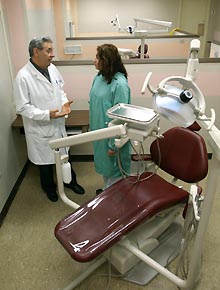|
This is an archived article.
For the latest news, go to the
Advance Homepage
For more archives, go to the Advance Archive/Search Page. | ||
|
New Chairs, New Look For Dental Clinics Buying new chairs is no simple redecorating job for a top-flight dental school. Just ask Dr. Joseph Grasso, associate dean for clinical affairs at the School of Dental Medicine. "It took months of planning," says Grasso of the installation of 110 new chairs and control units designed to ensure the school's compliance with standards for infection control, ergonomics, and patient comfort. The changeover was scheduled for the week of March 10-14, when students were on spring break and many faculty were scheduled to attend scientific meetings or take a vacation. The clinics, which treat more than 1,500 people every week, were closed; and emergency visits - there are generally about 35 a day - were transferred to the separate faculty practice area.
The old chairs, some more than 25 years old, were removed one by one after the wiring for each had been disconnected. The new chairs and control units were rolled off the delivery truck one at a time, wrapped carefully in quilted blankets, then reconnected, one by one, to the connections for electricity, plumbing, and air. "It was a monumental task," says Grasso, who supervised the work. "These are no ordinary chairs." Each chair has a self-contained water supply that can be monitored for purity without relying on tap water. The metal arm supporting the tray for equipment can swing 180 degrees to accommodate either left- or right-handed dentists, and can be adjusted so dentists can treat patients in wheelchairs when necessary. The attractive red leather is made without seams, and the chairs have a separate back and seat so they can be effectively swabbed down with disinfectant between patients. The buttons for adjusting the chair position are located on a panel that can be covered with plastic, which is removed and replaced after each patient to prevent the transfer of germs. The new chairs, financed by a $1.7 million capital expenditure approved by the state Bond Commission and purchased at a substantial discount from their $20,000 retail price from A-dec Inc. in Oregon, are the latest major upgrade for the dental clinics. Last year, with a separate $700,000 bond allocation, the school reconfigured its clinic space to revamp its sterilization process, creating separate areas for clean and dirty equipment and installing a large, state-of-the-art autoclave in a central sterilization area. The large autoclave eliminates the need for each clinic to sterilize its own equipment in its own autoclave and makes the process easier to monitor for quality control. Grasso notes that the school must comply with several different regulatory groups, each with its own infection control standards: "The Health Center has an infection control committee. OSHA has its standards. The state has its regulations. And we are accredited every seven years by the American Dental Association Commission on Dental Accreditation, which has its own standards. The new chairs and the improved sterilization system allow us to meet the infection control standards of all those groups," he says. "We are the top dental school in the country," Grasso adds. "Now we have state-of-the-art facilities on a par with our academic status." |

